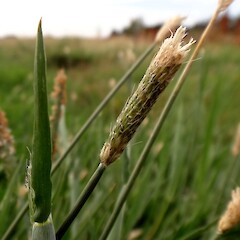Alopecurus geniculatus
Common name
kneed foxtail
Family
Poaceae
Flora category
Vascular – Exotic
Structural class
Grasses
NVS code
The National Vegetation Survey (NVS) Databank is a physical archive and electronic databank containing records of over 94,000 vegetation survey plots - including data from over 19,000 permanent plots. NVS maintains a standard set of species code abbreviations that correspond to standard scientific plant names from the Ngä Tipu o Aotearoa - New Zealand Plants database.
ALOGEN
Conservation status
Not applicable
Brief description
A sprawling mat-forming grass with creeping stems, often floating on water, with dense spiked flowerheads.
Distribution
Common throughout.
Habitat
Wide variety of wetland and aquatic habitats, rare in dry gravelly waste areas.
Wetland plant indicator status rating
Information derived from the revised national wetland plant list prepared to assist councils in delineating and monitoring wetlands (Clarkson et al., 2021 Manaaki Whenua – Landcare Research Contract Report LC3975 for Hawke’s Bay Regional Council). The national plant list categorises plants by the extent to which they are found in wetlands and not ‘drylands’. The indicator status ratings are OBL (obligate wetland), FACW (facultative wetland), FAC (facultative), FACU (facultative upland), and UPL (obligate upland). If you have suggestions for the Wetland Indicator Status Rating, please contact: [Enable JavaScript to view protected content]
FACW: Facultative Wetland
Usually is a hydrophyte but occasionally found in uplands (non-wetlands).
Detailed description
Sprawling grass rooting at the nodes, 15–45 cm tall; can form floating mats. Stems ascending from knee-like bends at the nodes. Leaf-blade 4–12 cm long and 1.5–2.5 mm wide with an acute tip. Ligule (1.5)–2–4.5 mm long, membranous. Flower heads are upright spikes 2–4 cm long comprised of densely crowded conspicuously awned spikelets.
Similar taxa
There are several similar sprawling wetland/aquatic grasses. Paspalum distichum has a shorter ligule and paired flower heads; Glyceria species have a boat-shaped leaf tip and cross-veins on the leaf sheath, and Agrostis stolonifera has a more open flower head.
Flowering
Spring and summer
Flower colours
Brown, Orange
Fruiting
Summer to autumn
Life cycle
Seed dispersed by water and contaminated machinery.
Year naturalised
1853
Origin
Eurasia
Reason for introduction
Pasture species.
Control techniques
Can be controlled manually, mechanically or herbicidally depending on situation.
Etymology
alopecurus: From the Greek alopekouros ‘fox-tail’
geniculatus: From the Latin geniculum ‘knee’, meaning ‘on bended knee’, often used in reference to plants with stems bent on an angle
Attribution
Factsheet prepared by Paul Champion and Deborah Hofstra (NIWA).
References and further reading
Edgar E, Connor HE. 2000. Flora of New Zealand. Vol. V. Grasses. Manaaki Whenua Press, Christchurch, NZ. 650 p.
Champion P. et al. 2020. Freshwater Invasive Species of New Zealand 2020. NIWA publication. https://docs.niwa.co.nz/library/public/FreInSpec.pdf
Johnson PN, Brooke PA. 1989. Wetland plants in New Zealand. DSIR Field Guide, DSIR Publishing, Wellington, NZ. 319 p.















